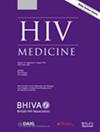People with HIV (PWH) are at an increased risk of developing cardiovascular disease (CVD) compared to HIV-negative individuals. We sought to evaluate the adherence to medications for CVD in PWH and identify factors associated with non-adherence to these medications.
We conducted a cross-sectional study at the University Hospitals of Leicester NHS Trust between 16 April 2019 and 8 November 2022. We recruited consecutive PWH, who were attending a routine follow-up outpatient appointment and were prescribed at least one medication for CVD. In addition, we included urinary adherence results of patients with samples collected as part of routine clinical care. We used liquid chromatography–tandem mass spectrometry (LC–MS/MS) to assess if their prescribed medications (antihypertensives, diuretics, beta-blockers, lipid-lowering agents, antiplatelets, anticoagulants, antidiabetic medications) were present in the participant's urine sample. Multivariable models were used to identify demographic or clinical features that were associated with non-adherence.
A total of 162 PWH were included in the analysis. Median age was 55 [interquartile range (IQR): 50–61] years, 63% were male, average time living with HIV was 15 years (IQR: 11–19) and the majority (98%) had an undetectable HIV viral load. In approximately one-third of patients (59/162), at least one prescribed medication of interest was not detected in urine. Non-adherence to lipid-lowering agents was common (35/88, 40%). On multivariable logistic regression, the number of prescribed cardiovascular medications, was associated with medication non-adherence [medication non-adherence, per one medication increase: adjusted odds ratio (95% confidence interval) = 1.78 (1.34–2.36); p < 0.001].
We found sub-optimal adherence to medications for CVD in PWH. In order to maximize the clinical benefit of statin therapy in PWH, factors requiring consideration include: improved medication adherence, awareness of polypharmacy, educational interventions and quantitative assessment of sub-optimal adherence through chemical adherence testing.



